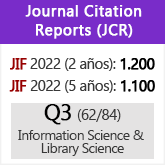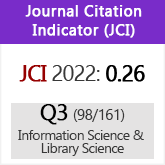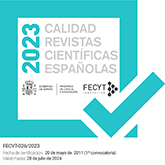La influencia de las autocitas en el aumento del factor de impacto en revistas de Ciencias Sociales
DOI:
https://doi.org/10.3989/redc.2010.2.722Palabras clave:
Factor de impacto, autocitasResumen
En este trabajo se indaga en el efecto de las autocitas en el aumento del factor de impacto en revistas incluidas en el Social Sciences Citation Index entre 1998 y 2007. Se estudian dos grupos de revistas: 63 cuyo factor de impacto aumenta después de cuatro descensos sucesivos y 23 revistas cuyo factor de impacto aumenta durante al menos seis años seguidos durante el intervalo estudiado de diez años. La variable fundamental es el porcentaje de autocitas que contribuyen al factor de impacto. En ninguno de los casos se encontró evidencia de que el factor de impacto haya aumentado debido a un uso masivo de las autocitas.
Descargas
Citas
Andrade, A.; González-Jonte, R., y Campanario, J. M. (2009): Journals that increase their impact factor at least fourfold in a few years: the role of journal self-citations. Scientometrics, 80 (2), 515-528. doi:10.1007/s11192-008-2085-9
Campanario, J. M., y González, L. (2006): Journal self-citations that contribute to the impact factor: Documents labeled «editorial material» in journals covered by the Science Citation Index. Scientometrics, 69 (2), 365-386. doi:10.1007/s11192-006-0158-1
Campanario, J. M., y Molina, A. (2009): Surviving bad times: The role of citations, selfcitations and numbers of citable items in recovery of the journal impact factor after at least four years of continuous decreases. Scientometrics, 81 (3), 859-864. doi:10.1007/s11192-008-2257-7
Chew, M.; Villanueva, E. V., y Van Der Weyden, M. B. (2007): Life and times of the impact factor: retrospective analysis of trends for seven medical journals (1994-2005) and their¡ Editors’ views. Journal of the Royal Society of Medicine, 100 (3), 142-150. doi:10.1258/jrsm.100.3.142 PMid:17339310
Falagas, M. E., y Alexiou, V. G. (2007): Editors may inappropriately infl uence authors’ decisions regarding selection of references in scientifi c articles. International Journal of Impotence Research, 19 (5), 443-445. doi:10.1038/sj.ijir.3901583 PMid:17786154
Frandsen, T. B. (2008): On the ratio of citable versus non-citable items in economics journals. Scientometrics, 74 (3), 439-451. doi:10.1007/s11192-007-1697-9
Glänzel, W., y Moed, H. F. (2002): Journal impact measures in bibliometric research. Scientometrics, 53 (2), 171-193. doi:10.1023/A:1014848323806
Golubic, R.; Rudes, M.; Kovacic, N.; Marusic, M., y Marusic, A. (2008): Calculating impact factor: How bibliographical classifi cation of journal items affects the impact factor of large and small journals. Science and Engineering Ethics, 14 (1), 41-49. doi:10.1007/s11948-007-9044-3 PMid:18004672
González, L., y Campanario, J. M. (2007): Structure of the impact factor of journals included in the Social Sciences Citation Index: Citations from documents labeled «editorial material». Journal of the American Society for Information Science and Technology, 58 (2), 252-262. doi:10.1002/asi.20424
González, G.; Castellano, M.; Valderrama, J. C., y Aleixandre, R. (2008): Literatura científica de autores españoles sobre análisis de citas y factor de impacto en Biomedicina (1981-2005). Revista Española de Documentación Científica, 31 (3), 344-365.
Karlan, B. Y. (2008): Dawn of a new era for Gynecologic Oncology. Gynecologic Oncology, 108 (1), 2. doi:10.1016/j.ygyno.2007.11.021
Kirchhof, B.; Bornfeld, N., y Green, F. (2007): The delicate topic of the impact factor. Graefe’s Archive for Clinical and Experimental Ophthalmology, 245 (7), 925-927. doi:10.1007/s00417-007-0618-1 PMid:17562062
Kuk, Y. (2008): Editorial. Solid-State Electronics, 52 (7), 997. doi:10.1016/j.sse.2008.05.011
Lundberg, G. (2003): The «omnipotent» Science Citation Index Impact Factor. The IF is a poor measure of the worth of journals, journal articles and authors. Medical Journal of Australia, 178 (6), 253-254. PMid:12633479
Mannino, D. M. (2005): Impact factor, impact, and smoke and mirrors. American Journal of Respiratory and Critical Care Medicine, 171 (4), 417-418. PMid:15699080
McVeigh, M. E. (2002): Journal self-citation in the Journal Citation Reports, http://www.thomsonreuters.com/products_services/science/free/essays/journal_self_citation_jcr/ [consultado el 9 de abril de 2010].
Matías-Guiu, J., y García-Ramos, R. (2008): El factor de impacto y las decisiones editoriales. Neurobiología, 23 (6), 342-348.
Neuberger, J., y Counsell, C. (2002): Impact factors: uses and abuses. European Journal of Gastroenterology & Hepatology, 14 (3), 209-211. doi:10.1097/00042737-200203000-00001
Opthof, T.; Coronel, R., y Janse, M. J. (2002): Submissions, impact factor, reviewer’s recommendations and geographical bias within the peer review system (1997-2002): Focus on Germany. Cardiovascular Research, 55 (2), 215-219. doi:10.1016/S0008-6363(02)00500-X
Oreopoulos, D. G. (2000): Editor’s report 1999: Record high impact factor puts PDI in elite group. Peritoneal Dialysis International, 20 (1), 5-6.
Rew, D. (2008): Editor’s quinquennial report 2008. European Journal of Surgical Oncology, 34 (5), 485-486. doi:10.1016/j.ejso.2008.03.012 PMid:18406101
Sevinc, A. (2004): Manipulating impact factor: an unethical issue or An Editor’s choice? Swiss Medical Weekly, 134 (27-28), 410. PMid:15389359
Shugan, S. M. (2002): Editorial. The mission of Marketing Science. Marketing Science, 21 (1), 1-13. doi:10.1287/mksc.21.1.1.162
Smith, R. (1997): Journal accused of manipulating impact factor. British Medical Journal, 314, 461 (15 febrero).
Sorelle, R. (2001): Circulation impact factor is highest ever. Circulation, 104, 1450. doi:10.1161/hc3801.097482 PMid:11571232
Thomson Reuters (2009): Journal Citation Reports® Notices, http://admin-apps.isiknowledge.com/JCR/static_html/notices/notices.htm [consultado el 9 de abril de 2010].
Urti, A. (2003): Editorial. The new impact factor (1.84) and other recent developments in the European Journal of Pharmaceutical Sciences. European Journal of Pharmaceutical Sciences, 18 (1), 1. doi:10.1016/S0928-0987(02)00261-0
Descargas
Publicado
Cómo citar
Número
Sección
Licencia
Derechos de autor 2010 Consejo Superior de Investigaciones Científicas (CSIC)

Esta obra está bajo una licencia internacional Creative Commons Atribución 4.0.
© CSIC. Los originales publicados en las ediciones impresa y electrónica de esta Revista son propiedad del Consejo Superior de Investigaciones Científicas, siendo necesario citar la procedencia en cualquier reproducción parcial o total.Salvo indicación contraria, todos los contenidos de la edición electrónica se distribuyen bajo una licencia de uso y distribución “Creative Commons Reconocimiento 4.0 Internacional ” (CC BY 4.0). Puede consultar desde aquí la versión informativa y el texto legal de la licencia. Esta circunstancia ha de hacerse constar expresamente de esta forma cuando sea necesario.
No se autoriza el depósito en repositorios, páginas web personales o similares de cualquier otra versión distinta a la publicada por el editor.

















